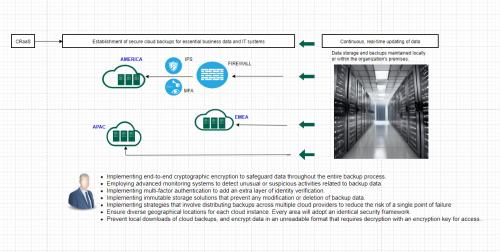Elevating SaaS Development with AI-Enhanced Threat Detection

In today's digital landscape, the prominence of Software as a Service (SaaS) solutions accentuates the criticality of cybersecurity. Amidst the escalating complexity of cyber threats, SaaS developers grapple with the formidable task of securing their platforms against malicious entities while maintaining uninterrupted user experiences. Traditional security protocols now fall short in addressing the evolving threat landscape, necessitating a shift towards innovative strategies. This is where AI-driven threat detection emerges as a transformative tool in fortifying SaaS applications against cyber risks.
Recognizing the Urgency for Advanced Threat Detection in SaaS Development:
The widespread adoption of cloud-based services has revolutionized business operations, offering unparalleled adaptability, scalability, and accessibility. However, this digital transformation has also exposed organizations to a spectrum of security vulnerabilities, ranging from data breaches to ransomware attacks. SaaS developers must acknowledge these inherent vulnerabilities within their platforms and take proactive measures to uphold user trust and regulatory compliance.
Conventional security methodologies, characterized by signature-based detection and rigid rule sets, lack the agility and efficacy required to combat modern cyber threats. These traditional approaches often struggle to identify sophisticated malware variants and emerging exploits, leaving SaaS applications vulnerable to compromise. Moreover, the dynamic nature of cloud environments further complicates threat detection, necessitating adaptive solutions capable of real-time analysis and response.
Harnessing AI for Enhanced Threat Detection Capabilities:
Artificial Intelligence (AI) emerges as a powerful ally in the ongoing battle against cyber adversaries, equipping SaaS developers with advanced threat detection capabilities. Through the utilization of machine learning, deep learning, and natural language processing, AI-driven security solutions can discern patterns, anomalies, and malicious activities within vast datasets, enabling proactive threat mitigation.
A significant advantage of AI-powered threat detection lies in its ability to rapidly analyze large volumes of data. Traditional security tools often struggle to manage the sheer volume of information inherent in cloud environments, resulting in latency issues and missed threats. In contrast, AI algorithms excel in real-time processing of extensive datasets, facilitating swift threat identification and response.
Furthermore, AI-driven threat detection systems possess adaptive learning capabilities, enabling continuous refinement and improvement over time. By continuously analyzing new threat vectors and learning from past incidents, these systems enhance their detection accuracy while minimizing false positives. This iterative learning process is crucial in the dynamic landscape of cybersecurity, where threat actors continuously evolve their tactics. It underscores the importance for DevOps services to integrate seamlessly, ensuring that security measures are updated and aligned with evolving threats.
Enabling Features for SaaS Development:
Integrating AI-powered threat detection into SaaS development requires a systematic approach, encompassing technical integration and user-centric considerations. Here are enabling functionalities that developers can leverage to enhance the security posture of their SaaS applications:
1.Behavioral Analysis: Utilize AI algorithms to analyze user behavior patterns and detect abnormal activities indicative of potential security breaches. By establishing baseline user behaviors, SaaS platforms can identify deviations signaling unauthorized access or malicious intent.
2.Predictive Analytics: Employ machine learning models to forecast potential security risks based on historical data and current trends. Predictive analytics empower SaaS developers to proactively mitigate threats before they escalate, safeguarding user data and platform integrity.
3.Automated Response Mechanisms: Integrate AI-driven automation to expedite threat response and remediation processes. By automating routine security operations such as threat assessment and incident handling, SaaS developers streamline security workflows and mitigate the impact of cyber attacks.
4. Continuous Monitoring and Reporting: Implement comprehensive surveillance mechanisms to monitor security events and generate actionable insights for stakeholders. Cloud service providers can utilize AI-powered dashboards and reporting tools to maintain comprehensive surveillance, ensuring visibility into security events and facilitating effective communication with clients and regulatory bodies.
Let's take an example of how secondary signature-based analysis is a valuable addition to AI detection methods in SaaS development, especially for handling polymorphic malware. Here's how it works:
Dynamic Signature Generation: Instead of static signatures, dynamic techniques generate signatures based on malware behavior during runtime. This captures variations in code and execution patterns, improving detection accuracy.
Behavioral Analysis: It focuses on behavioral patterns of polymorphic malware, correlating them with signature patterns to identify threats by monitoring system activities.
Heuristic Analysis: Heuristic techniques identify polymorphic malware based on suspicious behavior or code attributes, flagging potential threats by analyzing deviations from normal behavior.
Pattern Recognition: Advanced algorithms detect recurring patterns within polymorphic malware, analyzing code fragments or behavior to identify common features among variants.
Integration with AI Models: It seamlessly combines with AI-driven detection, allowing AI models to learn from signature-based analysis and adapt to emerging threats, improving detection accuracy.
Real-Time Updates: Regular updates to signature databases are essential to combat evolving malware. Automated update mechanisms ensure detection systems remain up-to-date with the latest signatures.
Secondary signature-based analysis enhances AI detection for polymorphic malware in SaaS development, offering a comprehensive defense mechanism crucial for cloud server providers in India, and IT consulting companies in India.
Conclusion:
In an era defined by digital transformation and increasing cybersecurity threats, SaaS developers must prioritize security throughout the application development lifecycle. AI-powered threat detection offers a potent solution to the evolving challenges of cybersecurity, enabling proactive threat mitigation and risk management enhancements. By leveraging advanced AI algorithms and enabling functionalities, SaaS developers can fortify their platforms against malicious entities while delivering seamless user experiences. Embracing AI-driven security solutions is crucial in safeguarding the integrity, confidentiality, and availability of SaaS applications, especially as the cybersecurity landscape continues to evolve.









Comments (1)
Random India
9
Digital Marketer
Free Blog Submission Sites 2024
handyclassified.com
thenewsbrick.com
blognow.co.in